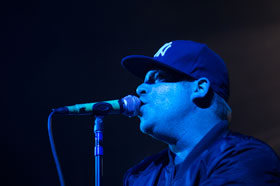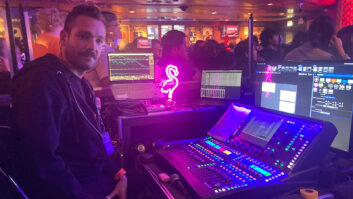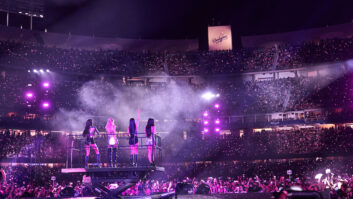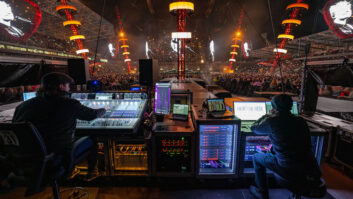
El-P.
Photo: Matthew Ismael Ruiz
Touring in support of his critically acclaimed album Cancer 4 Cure, El-P hit the road this summer with a group of notable DJs, rappers and musicians including Killer Mike, Mr. Muthaf**kin’ eXquire and Despot. The tour, titled Into the Wild (a shout-out to Maurice Sendak’s Where the Wild Things Are), delivered a four-hour head-nod and fist-pump fest to amped audiences, leaving a trail of thrilled—and sweaty—bodies in its wake.
Front-of-house engineer Ian McCarthy has this “traveling circus” of sorts covered on the boards. Mix caught up with McCarthy to find out how he handles the ins and outs (literally) of the tour.
“Because this tour is a package deal with four acts, it was important to create one unified stage layout,” McCarthy says. “That way if we were running late—as hip-hop shows tend to—we could eschew changeovers completely.”
McCarthy describes the stage layout: “We set up one six-foot DJ table upstage center, which holds turntables, mixer, DJ controllers and samplers. This is the source of all music for the first three acts. Flanking this table is El-P’s band. Torbitt Schwartz, aka Little Shalimar [El-P’s band leader; also in the band Chin Chin], sets up to the right side of the stage, facing center stage about 30 degrees. His rig starts with Serato playback of stripped-down stem versions of the new album. Next to his computer are a cymbal stand fitted with a Roland SPD-S, a set of bongos and a cymbal. These fill out the more percussive elements of the backing tracks and [with some reverb] give the programmed beats a little bit more of a live feel. Shalimar also has a Yamaha CS01 and a MIDI keyboard to trigger Moog Animoog for iPad. Additionally, he plays guitar and sings.
“Mirroring Shalimar on stage left is his brother Wilder Zoby Schwartz [also of Chin Chin]. He plays a Moog Liberation, a Nord Electro and a Critter & Guitari Pocket Piano, and he also sings. After that we have two mics: one for El-P and one for his hype man, Shannon Moore of Activator. Some nights we add horn players, guest singers, more synths‚ but this is our standard setup.”
McCarthy adapts his setup for each artist’s specific needs for the performance, which is especially important when you have multiple MCs. “For this tour I carry six handheld vocal mics for the MCs,” McCarthy says. “They’re each wrapped in different colors of electrical tape. That way, each MC is likely to grab the correct mic. And if they don’t, the venue monitor engineers will instantly know which mic they’re on. Since all of the MCs have different mic handling techniques, the gain, compression and EQ vary a lot, so it’s important to keep them on their own mics.
According to McCarthy, the mic preamp is also important. “I also carry a stereo ART MPA Gold mic preamp—it’s affordable, reliable and features easy impedance control, which really helps focus the mic depending on physical characteristics of the room and stage. I run channel 1 for El-P’s vocal and channel 2 for Killer Mike. It’s run as a true insert—mic straight in then balanced out to the console’s line input, bypassing the console head amp.”
McCarthy says the preamps also come in handy for small venues, where he’s handling monitors from front-of-house and the house sound engineer runs double-duty as promoter. “The artists are out eating or showering or finding a clean restroom, and I’m alone in the venue. In that case, I can simply pin the two mics—knowing that my preamp gains are still set appropriately from the night before and there’s a lot less guess work gaining the console line input if at all—and ring out any feedback from FOH with only one or two trips back and forth.”
For this tour, McCarthy carries a few FX units. “I really like this unit [the Roland SDE-1000] because of the sound foremost, but also the control and speed of use,” McCarthy says. “The feedback button activates the feedback knob, and if abused just the right amount, it results in really cool delay swells. I tend to mix a little delay heavy, and for hip-hop in medium-size venues, it really helps make the room seem bigger in a way.
“I also use the Yamaha SPX2000,” McCarthy continues. “I tend toward the SPX family because I really like their distortion algorithms. One thing that I use this unit for every night is the pitch shift. Despot is a solo act, so having a down-tuned clone of his voice allows me to pepper in a ‘hype man’ for him at times during his set.”






